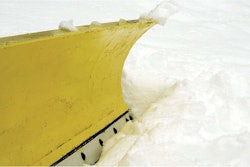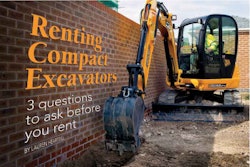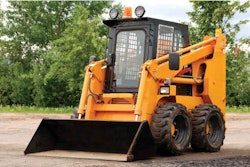When you do the math, they give you a competitive advantage.
Whether you operate a small, start-up landscape company looking to invest in your first piece of major equipment, or you own a large company with a hefty equipment budget to match, you want to invest in machinery that will give you the most bang for the buck. Some debate the skid steer offers the most versatility, but for many landscape contractors, the compact utility tractor may yield a better choice.
Calculations
Return on Investment
Tractor vs. skid steer
The utility tractor’s price point is one of the first attractions for business owners, says Roger Gifford, product marketing specialist for Massey Ferguson. “The purchase price is considerably less than a skid steer,” he says, “and the versatility is higher. This equates to less start up investment, which increases the return on investment by higher profits per hour of operation, without sacrificing capability.”
Operating costs
Attachments such as pallet forks come in handy for transporting pallets of plants, sod, stone and other products.Ongoing costs are lower for the utility tractor when compared with skid steers, says Joe Miller, product specialist for Bobcat. “Maintenance is usually easier and less costly,” he says. “Fuel consumption is also lower.” Owners with a limited budget might also consider the tractor’s lighter weight, which translates to less expensive equipment (lighter-duty trailer and truck) to haul it. “Compact tractors are easier to transport and drive based on the size of machine,” Miller says. “They offer many attachment solutions that are less costly than skid steer attachments.”
Offer More Services
“We’ve noticed landscapers have transitioned from being more specialized to offering a wider variety of services, and being able to provide start to finish on [broader] projects,” Miller says. “Those who used to do just paver patios are now doing irrigation and water features to keep crews busy. With the flexibility of a compact tractor, it is easy for landscapers to adjust service offerings by simply adding attachments.”
Lighter Footprint
The tractor’s lighter weight also leads to less ground disturbance on the jobsite, a feature some manufacturers say has been a strong selling point in recent years. Several years ago, landscapers were doing more installation jobs on new properties that offered a blank slate jobsite. In today’s market, where landscape renovation has shown the most growth, maneuverability and lighter ground impact are important features. With landscape renovations, often plants and hardscapes are being removed and replaced, but surrounding turf needs to be preserved. Using a skid steer, particularly one on tracks, might require spending more time and money covering your tracks.
Dividing and Multiplying
When it comes to selecting the right model of utility tractor “it really depends on what the customer is going to do with the tractor,” says Richard Kershner, product marketing manager for compact utility tractors at John Deere. “For example, if the equipment will be used in an application such as mowing, the need for four-wheel drive might not be needed. Two-wheel drive tractors tend to be a little more forgiving in turf environments.”
Compact tractors offer many attachments solutions that are less costly than skid steer attachments.
Four-wheel drive or Two-wheel drive
If you encounter a lot of hilly terrain or you do a lot of loading, a four-wheel drive model will perform better. For lighter compact utility tractors – even with ballast on the back – driving into a pile of heavy material with the front-end loader causes the back end to become lighter, and the tractor loses traction. A four-wheel drive model will perform better in such situations.
“If you’re just rotary cutting properties, two-wheel drive works well for maneuverability,” Gifford says. “If you’re grading, loading or pulling trailers or ground engaged equipment, the front wheel assist is necessary for the compact utility tractor to have adequate traction.”
Tire Selection
You’ll probably want the “middle-of-the-road” tire type, but several tire selections exist. “The most popular is the industrial/general purpose tire,” Miller says. “This tire offers good traction while not tearing up turf excessively.”
Agriculture tires are necessary for soft soil conditions, Gifford says. “They dig deep to find hard ground for traction. There are several types of turf tires – general turf for mowing and maintaining properties, low profile for mowing and running turf machines and industrial for heavy loader and grading applications. Low profile turf tires are the most popular tires selected.”
Attachments
The most common three-point attachments on Bobcat’s compact tractors include augers, tillers, box blades, angle blades, snow blowers, soil conditioners and tine rakes, Miller says.
“A tractor’s rear PTO allows a multitude of attachments to be powered, from power box graders, rotary tillers and rotary cutters,” Gifford says. “The front PTO allows for mid-mounted mowers to be installed, or front mounted snowblowers.”
Utility tractors’ lighter weight leads to less ground disturbance, which is a plus for renovation work.For improved versatility, you can add quick-attach capabilities for the front arms. Gifford recommends a curved boom backhoe with boom float control, which improves a machine’s ability to excavate, trench and remove stumps or other objects from the landscape. “The compact utility tractor can be adapted with a triple rear remote system, which enables it to use a Top-N-Tilt system,” he says. “This changes the top link of the three-point system to a hydraulic cylinder and the adjustable link on the lift arm to a hydraulic cylinder. Then the operator can use attachments such as power box graders with increased productivity.” The advantage here is the operator can control the aggressiveness of the attachment or control the feathering effect along with the pitch from side to side, allowing the operator to make grading compensations on the fly, Gifford says.
Website Tutor
John Deere offers a helpful website (deere.com) product selector tool to help buyers decide which model best suits their needs. The “Needs Analyzer” program works by identifying the primary task of the tractor (loading, tilling, mowing, etc.), the secondary task (loading, tilling, etc.), how high material will be lifted (4 feet to pickup bed height, 7 feet to dump truck height, 11 feet to semi trailer), the acreage you typically mow and the length of time you want to spend mowing.
Measuring Tractor hp
Horsepower is measured in three places: the engine, the PTO (power take-off) and at the drawbar.
PTO hp typically = 75 to 85 percent gross engine hp.
Tractor’s ability to do tillage work such as plowing, disking and box grading is affected by its drawbar hp.
Drawbar hp typically = 75 to 85 percent PTO hp.









